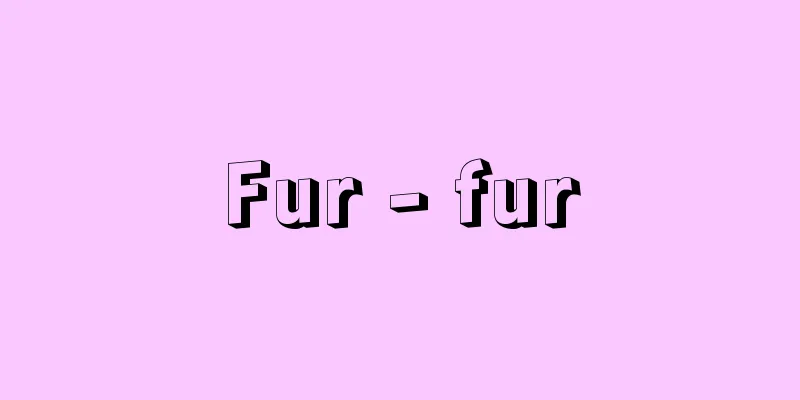Fur - fur

|
It can also be read as "mouhi." Generally, fur is the material that can be used after the skin of a mammal has been removed and tanned. However, fur should actually refer to raw fur or raw fur that has been temporarily treated with preservatives. In English, the tanning of fur is called "dressing" rather than "tanning," and even after tanning, it is simply called "fur." This is evidence that the emphasis is on the finish of the fur, and not on the tanning process itself. Fur has excellent properties as a clothing material to keep warm, but modern people place more importance on its value as an ornament than as a means of keeping warm. [Eijiro Kanno] historyIt is said that furs peeled from animals have been used as is for clothing and housing since the Paleolithic period. Since furs fall out and rot if left as is, it is thought that processing techniques such as tanning were gradually developed, but the process is not clear. Unique techniques were developed in each region, and as transportation opened up, raw materials and techniques were exchanged, leading to the present day. Furs were originally used by northern peoples to keep warm, but this custom spread south and reached Greece around 1500 BC. Tanning techniques were developed in China around 1000 BC and spread westward, spreading throughout Europe from the 18th century onwards, with processing techniques improving at the same time. During this period, nobles used furs from foxes, martens and weasels, while common people used furs from sheep, dogs and cats. From this time onwards, furs, which were primarily used to keep warm, gradually gained decorative value due to their beautiful appearance, feel and luxury, becoming a fashionable item and considered a treasure like jewels. As the raw material is wild animals, fashions have always been closely linked to resources. In the 18th century, sea otters from the North Sea were popular, but as resources became depleted, they shifted to fur seals and then to black foxes. From this time onwards, attempts were made to farm wild animals, and at the same time, progress was made in improving quality, leading to success in farming silver foxes, which became the focus of the fad. Production was temporarily halted during World War II, but after the war wild minks were successfully farmed in the United States and Canada, leading to improvements in the breed, and today's farmed minks (ranch minks) were born. These species of mink were exported all over the world, and farming became popular in many places, which is why minks are so popular today. In addition, the fur (astrakhan) of the karakul sheep, a type of sheep, is produced in the Near East and Africa, and is used as a luxury fur. In Japan, fur has been used for clothing and footwear since before Christ, but the amount used is very small. From the end of the Meiji period, its use increased mainly as protection against the cold, but it was only when silver fox farming began in the Showa period that it became a fashionable item. After the war, mink breeds were imported from the United States, and their breeding became more and more popular each year, and they began to be exported in large quantities as raw fur, just like rabbit fur. At the same time, domestic tanning has increased, and domestic consumption is also on the rise. In addition to rabbit fur, a popular product is chrome-tanned and dyed fur made from the short hairs left over after the wool is shorn from Merino sheep. [Eijiro Kanno] Manufacturing methodAfter an animal is slaughtered, the flesh and fat are removed from the hide, salt is spread on the hide, and the hides are piled together with the flesh side facing up, or placed on a board to dry, creating the raw fur. These raw furs are then sent to factories, where they go through three processes - preparation, tanning, and finishing - before becoming finished products. (1) Preparation process The dried raw fur is soaked in water to absorb water and soften it to the state of raw fur, and is washed at the same time. Next, a knife is used to remove any chunks of flesh and connective tissue remaining on the surface of the fur. Furthermore, any fat contained in the hide is also removed. If these steps, and the subsequent degreasing step, are not done properly, the tanning will not be complete and the end product will be hard. For degreasing, a warm solution of neutral detergent or soap, or an organic solvent such as industrial gasoline is used. In this case, care must be taken, as if the alkalinity is too strong or the temperature is too high, the fur may felt or fall out. (2) Tanning process After degreasing and rinsing, the leather is soaked in a tanning solution for tanning. Tanning agents include alum, basic chromium and aluminum salts, oil, various aldehydes, synthetic oils, and wood vinegar. Tanning with alum has been practiced since ancient times, and involves soaking the leather in a mixed solution of alum and table salt. It produces white, flexible leather with a high surface area yield. On the other hand, it reverts to its rawhide state when it absorbs moisture and is susceptible to insect damage, so basic aluminum or chromium salts must be used. When dyeing is required in particular, other tanning methods must be used, or a combination of these methods must be used. In chrome tanning, the fur is first soaked in a solution slightly less concentrated than alum tanning solution, or in a mixture of acid and salt, and then soaked in a mixture of basic chromium salt and salt. Fur tanned with chrome has a bluish tinge and low surface area yield, but it is flexible and strong, changes little in response to water, and is heat-resistant. Synthetic oil tanning involves soaking the fur in synthetic oils such as sulfonyl chloride-based hydrocarbons. The leather is finished in a white color and is resistant to water, so it is used for tanning luxury items. (3) Finishing process Originally, the beauty of fur was determined by the color, luster, and texture of the natural hair. For this reason, furs of poor color are dyed to turn them into high-quality imitations. Synthetic dyes such as direct, acidic, basic, and oxidative dyes are mainly used. Since fur is less dyeable than leather, the process is carried out at a relatively high temperature (about 60°C). Alum tanning is weak against water, so it is either brush-dyed with special dyes or dyed for a short time at a low temperature. Basic dyes produce vivid colors, but have the disadvantage of fading easily when exposed to light. In contrast, oxidative dyes are limited in color and have a high light resistance, although there is a risk of damaging the fur. Hair is divided into three types, each with different properties. First, down (watage). The surface is densely packed with curly hairs, which feel good to the touch, have good heat retention, and dyeability. Next is stiff hair (goumou or tobige). Of the three types, it is the longest and straightest, and the quality of the color depends on the color of the stiff hair. It does not dye well, so it is treated with an oxidizing agent before dyeing. Finally, there is coarse hair (soumou or aragesu). This has properties intermediate between the previous two types. To improve flexibility and feel, it is first greasing. Usually, oil and surfactant are applied to the flesh side, and the leather is left stacked for several dozen hours before drying. After drying, moisture is added from the flesh side, and the leather fibers are loosened and stretched with a knife or other tool. The leather is then dried and beaten several times until it is completely dry. After drying, the fur is given a glossy finish, the flesh side is sanded, and the fur is straightened with a combing machine to produce the finished product. [Eijiro Kanno] kindsLike leather, leather is classified by the type of animal, the tanning method, and the purpose. It can be used for a wide variety of purposes, including coats, stoles, boas, scarves, hats, slippers, and rugs. Even within the same species, there are "wild" and "farmed" animals, and the two have different characteristics. Needless to say, wild animals are gradually decreasing in number. Let's classify them by the type of animal. (1) Rabbits There are wild and farmed rabbits. Wild rabbits are called wild rabbits or mountain rabbits, and generally have thin skin and weak fur. Farmed rabbits are of better quality. Farmed rabbits in Japan are of good quality and are mass-produced, so they are also popular as an export item. (2) Weasel: The most common in the wild. Its fur is pale yellow or reddish brown, and when dyed blackish brown, it takes on a luster and color similar to that of ranch mink (farmed mink). The quality of its fur is also good, so it is used as a mink substitute. (3) Mink There are wild and farmed minks, but the wild one is another name for the weasel. Farmed mink fur is several times better and stronger, so it is prized as a top-quality product. In areas such as Hokkaido, where the climate is suitable for farming and feed is relatively easy to obtain, farming is thriving. There are many types of mink, and the quality of the fur varies depending on the type. Undyed fur is called natural mink. (4) Foxes: In the past, they were captured in the wild and used for products, but nowadays they are farmed. They have long, luxurious fur and are very durable. Depending on the color of their fur, they are called silver foxes, white foxes, etc. (5) Sheep There are many kinds of sheep, and the quality of their wool naturally varies depending on the type. The fur of mature sheep is heavy and is used for rugs and slippers, while the fur of light lambs is used for coats. Recently, sheep fur (mutton) has been imported in large quantities, and is chrome-tanned and sold for rugs and other purposes, and is very popular. (6) Marten There are no farmed martens, and their fur is longer than that of a mink but shorter than that of a fox. The most representative are the Russian sable and the Japanese brown marten. Sable is a dark gray-brown color and is considered the highest quality. Brown martens are pale yellow in color and are a beautiful color, but are considered inferior to sable. Japan also produces martens other than brown martens, but as their color is sooty and pale yellow, they are usually dyed blackish brown or brown before being made into products. (7) Squirrels: Wild squirrels are used. Those from the northern countries are beautiful with a silvery grey color, but those from the southern countries are brownish and less beautiful. There are very few in Japan, and most are imported from Russia. The fur is short, dense and soft. [Eijiro Kanno] Care and PreservationIt is important to avoid water and humidity as much as possible while using it, and to be careful not to get it dirty. If it does get dirty, it is important to take care of it as soon as possible. Damage to fur is often caused by dirt, insect damage, mold, etc., so care must be taken. After wearing, brushing in the direction of the fur to remove dust, or sometimes tapping the fur lightly with a thin, flexible stick to remove dust, will also help make the fur stand up and return to its fluffy state. Water-soluble stains can be removed with warm water, and oil-soluble stains can be removed with an organic solvent such as benzine, and only the dirty parts can be wiped lightly. Alternatively, sawdust or flour can be sprinkled on the surface of the fur and lightly rubbed to allow the sawdust to absorb the dirt, but expensive furs can be greatly damaged if not cared for properly, so it is safer to leave it to a professional. Even for simple stain removal, it is best to be careful and try it on an inconspicuous area first. After caring for the fur, dry it thoroughly in a well-ventilated shade, put an insect repellent in it so that it does not come into direct contact with the fur, seal it, and store it in a dry, cool, dark place. At dry cleaning shops, depending on the level of dirt, for spot stains, they soak sawdust in an organic solvent, sprinkle it on the dirty fur, and gently rub it to remove. If the stain is widespread, the fur and sawdust soaked in the solvent are placed in a washer (a spin-type washing machine), the dirt on the fur is transferred to the sawdust, the sawdust is removed, and any messy fur is straightened out with an iron. Some shops also accept fur storage in rooms that have been adjusted to suit this purpose. Shedding may occur during wear or care, which may be due to microbial infestation of the hair roots prior to tanning, or due to improper manufacturing, wear, or care. [Eijiro Kanno] Fur outfitsFur clothing includes coats of all lengths, capes, cloaks, jackets, vests, boleros, ponchos, skirts, dresses, suits, etc., and the designs are becoming more and more diverse. Fur is also used as part of clothing, such as collars and cuffs, but it is also often used for lining and trimming of clothing. Incidentally, the original meaning of the English word fur is to line clothing. Fur coats with fur linings and reversible coats with fur on both sides can also be seen. Fur accessories include hats, ear wraps, collars, scarves, stoles, boas, muffs, boots, slippers, handbags, and accessories. Wearing fox scarves or mink stoles with Japanese clothing is a uniquely Japanese fur fashion that has been around since the early Taisho period. Originally, fur accessories were decorative items that served practical purposes such as protection from the cold and waterproofing, but some, such as earrings and brooches, are used purely for decorative purposes. Fur materials have also entered an era of diversification. For example, in 1976, Italian Giancarlo Ripa introduced computer fur (creating original patterns using a computer), proving that the possibilities of fur material are limitless. Designs formed from combinations of different fur materials and a variety of colors, supported by advanced tanning, dyeing, and sewing techniques, were said to be an industrial revolution in the fur industry. Intricately crafted, highly wearable fur modes are leading the way in fashion, and their uses are becoming increasingly diverse in line with the demands of the times. Formal wear used to be limited to a few things, such as ermine (a small European weasel), mink (a North American weasel-like animal), chinchilla (a South American squirrel-like animal), sable, and astrakhan (lamb fur), but now the formality of the material has faded, and the distinction between formal and casual wear is determined by design rather than material. With the wave of diversification in fashion, the range of furs worn has expanded. However, the basic principle remains that white fur is for night wear, regardless of the animal, and wild animal fur with bright spots is for daytime wear. For mourning, you are naturally limited to dark colors. It is important to choose a design that suits the time, place, and occasion, such as a long coat or stole with classic lines for formal occasions and a short coat or blouson with an active design for everyday wear, but there are also free combinations, such as jeans and fur. In the late 1970s, the demand for fur in Japan grew rapidly. In the 1980s, fur fashion spread at an accelerated pace, and Japan experienced its first fur boom. In recent years, furs that have become popular in Europe include marmot (an animal similar to a squirrel), blue fox, and wolf, while mink is of average popularity, and astrakhan is rapidly increasing in popularity. In Japan, mink, fox, and swakara (Karakur lamb) are popular, and practical mouton is popular among young people. Recently, interest in wildlife conservation and ecology has increased, and the wearing of extravagant furs tends to be criticized. In general, cheap fake fur (imitation fur made from synthetic fibers) is a popular substitute. [Hirano Yuko] Fur customsFur is an indispensable clothing for people living in cold regions such as Siberia and Alaska, as it provides excellent protection from the cold and was once relatively easy to obtain in the inhabited areas. The Eskimos and Inuit of North America use fur from the animals that are most readily available, such as caribou (reindeer), seals, or wolves. Fur is used for everything from hats to jackets, trousers, boots, and gloves. When shooting an animal for fur, it is common to aim for the eyes to avoid damaging the fur. Thread made from tendons is used for sewing. In the area inhabited by the Oroqen people in northeastern China, roe deer were once abundant, and when they kept reindeer and lived a nomadic life, relying on hunting in the forests, their fur played an important role in their lives. They used long, hairy clothes for winter and less hairy clothes for summer, but they wore their clothes with the hairy side on the inside. When a baby was born, it was washed and immediately wrapped in roe fur. They also covered their tents, which were their homes, in winter to keep out the cold. The Koryak people who live on the Kamchatka Peninsula in Russia, used furs from reindeer, deer, bear, and dog, but their funeral clothes were made from the fur of a white baby deer. They used fur, tendon thread, dyed reindeer and seal hair, and beautifully decorated them with embroidery, edging, and tassels. It was so elaborate that it took a woman an entire winter to complete one piece. Every Koryak prepared this for emergencies, always leaving one part unfinished, and when someone died, they quickly completed it and the deceased was burned in it. Furs are also used in places for purposes other than practical use. In ancient Egypt, leopard fur was used for monks' robes and became a symbol of religious beliefs. The Japanese god of thunder wears a tiger fur, which is thought to represent his bravery. Furs are also valuable and expensive, so they serve as status symbols. One example of this is when King Henry VIII of England (reigned 1509-47) issued an order banning anyone other than members of the royal family from wearing black fur, and in particular restricting the wearing of black marten to those with the rank of viscount or higher. [Hiroko Yokoyama] “Fur Tanning Dyeing Appraisal Preservation Method” by Satoshi Sawayama (1934, Kyoritsu Publishing) ▽ “Fur Story” by Koi Uemura (1967, Bunka Publishing Bureau) ▽ “Fur Book” by Kiyoji Nakamura and Setsuko Nishikawa (1977, Bunka Publishing Bureau) ▽ “Wool Culture Story” by Akihiro Yamane (Kodansha Academic Bunko) Source: Shogakukan Encyclopedia Nipponica About Encyclopedia Nipponica Information | Legend |
|
「もうひ」とも読む。一般には哺乳(ほにゅう)動物の皮膚をはいで被毛のままなめし、それが素材として使用できる状態のものを毛皮とよんでいる。しかし本来は、はいだままの生毛皮、または一時的に防腐処理を施した原料毛皮などを総称して毛皮というべきだろう。英語では、毛皮のなめしをタンニング(なめし)といわずに、ドレッシング(加工)といい、なめしたあともただファー(毛皮)という。このことは、毛の仕上がりを重視し、なめしそのものに重点が置かれていない証拠であろう。毛皮は防寒用服飾材料として非常に優れた性質をもっているが、現代人は防寒用というより装飾品としての価値に重きを置いている。 [菅野英二郎] 歴史動物の本体からはがした毛皮を、そのまま衣服・住居などに使用したのは、旧石器時代からといわれている。そのままでは毛が抜けたり腐敗することから、なめしなどの加工技術が徐々に発達したものと考えられるが、その経過は明らかではない。各地に独得の技術が発達し、交通が開けるとともに、原料および技術が交流しつつ今日に至っている。 毛皮は北方民族が防寒用として使用したのが始まりであるが、この習慣が南下し、紀元前1500年ごろギリシアに伝わっている。中国では前1000年ごろにはなめしの技術が発達し、これが西に伝わり、18世紀以降はヨーロッパ全土に普及し、同時に加工技術は一段と進歩した。この時代は、貴族はキツネ、テン、イタチなどの毛皮を、一般庶民はヒツジ、イヌ、ネコなどの毛皮を使用していた。このころより、主として防寒用に使われていた毛皮が、その美しい外観、感触、豪華さなどから、しだいに装飾的価値を高め、流行品の一つとなり、宝石同様に財宝とされていた。原料が野生動物であるため、流行はつねに資源と深いかかわりをもちつつ推移した。18世紀に北洋のラッコが流行したが、資源の枯渇からオットセイに、さらにクロギツネに推移した。このころから野生動物の飼育が試みられ、同時に品質改良が進み、ギンギツネの飼育に成功し、これが流行の中心となった。第二次世界大戦により一時生産が中断したが、戦後アメリカ合衆国・カナダで野生のミンクの飼育に成功し、それに伴って品種も改良され、今日の養殖ミンク(ランチミンク)が生まれ、この種ミンクが全世界に輸出され、各地で養殖が盛んになり、このため今日のミンクの流行となった。このほかにヒツジの一種カラクールの子の毛皮(アストラカン)が、近東、アフリカなどで産出し、高級毛皮として利用されている。 日本でも、毛皮は紀元前より衣料、履き物などに使用されていたが、その量は非常にわずかである。明治末期より主として防寒用として増加したが、流行品として登場したのは昭和に入りギンギツネの養殖が始まってからである。戦後、種ミンクをアメリカ合衆国から輸入し、その飼育が年々盛んになり、原料毛皮としてウサギと同様多数輸出されるようになった。また同時に国内でのなめしも増加し、それにつれて国内での消費も増加しつつある。大衆品ではウサギの毛皮のほかに、メリノー種ヒツジの毛を刈り取った、短毛の残った毛皮をクロムなめし・染色したものが広く出回っている。 [菅野英二郎] 製造法動物を畜殺してはいだ生皮から肉塊や脂肪塊を除き、その面に食塩を散布し、その肉面側どうしを重ね合わせて積み重ねるか、あるいは板にはって乾燥させ、原料毛皮をつくる。この原料毛皮が工場に送られ、準備、なめし、仕上げの3工程を経て製品となる。 (1)準備工程 乾燥した原料毛皮は、水につけて生毛皮の状態まで吸水、軟化させ、同時に洗浄する。次に銓刀(せんとう)などで、肉面に残っている肉塊、結合組織を除く。さらに皮中に含まれている脂肪なども除去する。これらの作業と、続いて行う脱脂作業が不完全だと、なめしが完全に行われず、製品は硬く仕上がってしまう。脱脂には中性洗剤、せっけんなどの温溶液、または工業用ガソリンのような有機溶剤を使う。この場合、アルカリ性が強すぎたり、温度が高すぎると、毛がフェルト化したり脱毛することがあるので、注意を要する作業である。 (2)なめし工程 脱脂、水洗後なめし液につけてなめす。なめし剤には、ミョウバン、塩基性のクロムおよびアルミニウム塩、油、各種アルデヒド、合成油、木酢(もくさく)液などが用いられる。ミョウバンによるなめしは古くから行われ、ミョウバンと食塩の混合溶液につけてなめす。白色の柔軟な革が得られ、面積の歩留りがよいのが特徴である。反面、水分を吸うと生皮の状態に戻るし、虫害にも侵されやすいので塩基性のアルミニウムまたはクロム塩などを使う必要がある。とくに染色などを行うときは他のなめし方法にするか、併用しなければならない。 クロムなめしは、あらかじめ、ミョウバンなめし液よりやや濃度の低い液、または酸と食塩の混合液につけて浸酸を行い、ついで塩基性クロム塩と食塩の混合液につけてなめす。クロムでなめした毛皮は青みを帯び、面積の歩留りが悪いが、柔軟で強度があり、水に対する変化は少なく、耐熱性のある毛皮ができる。合成油なめしは、炭化水素をスルホニール・クロライド化した合成油などにつけてなめす。革は白色に仕上がり、水に対しても強いので、高級品のなめしに使用される。 (3)仕上げ工程 元来、毛皮の美しさは天然の毛の色彩、つや、風合いによって価値づけられる。そのため、色の悪い毛皮を高級品のイミテーションに仕上げる目的などによって染色が行われる。染料には主として直接性、酸性、塩基性、酸化染料などの合成染料が用いられる。毛は皮よりも染着性が悪いので、比較的高温(約60℃)で行う。ミョウバンなめしは水に弱いので、特殊な染料で刷毛(はけ)染めするか、短時間低温染色する。塩基性染料は鮮明な色が出るが、光に当たるとあせやすいという欠点がある。これに対し酸化染料は色が限定され、毛を損傷する危険はあるが耐光性は高い。 毛は3種類に分けられ、それぞれ性質が異なる。まず綿毛(わたげ)。表面に縮れた毛が密生して感触がよく、保温性も高いし染色性も良好である。次に剛毛(ごうもう)(または飛毛(とびげ))。3種のなかでもっとも長く、直毛で、色彩のよしあしはこの剛毛の色による。染色性はよくないので、酸化剤で処理しておいて染色する。そして粗毛(そもう)(または荒毛(あらげ))。これは前2種の中間的な性質である。柔軟性や感触を改善するために、まず加脂を行う。普通、油脂と活面活性剤を肉面のほうから塗り、数十時間積み重ねておいたのちに乾燥させる。乾燥後、肉面から水分を与え、銓刀などで革の繊維をほぐしながら伸ばす。ついで乾燥、銓打ちを数回繰り返しながら完全に乾燥させる。乾燥後、毛に光沢を与え、さらに肉面をサンドペーパーがけし、梳毛(そもう)機で毛並みを整えて製品とする。 [菅野英二郎] 種類革と同様、動物の種類、なめし、用途によって分類される。用途は、コート、ストール、ボア、スカーフ、帽子、スリッパ、敷物など多岐にわたる。また、同種の動物でも「野生」と「養殖」とがあり、この両者では性質が異なる。野生の動物はしだいに減少しているのはいうまでもない。動物の種類によって分類してみよう。 (1)ウサギ 野生と養殖とがあり、野生のほうを野ウサギまたは山ウサギといい、皮は一般に薄く、毛も弱い。品質は養殖ウサギのほうがよい。日本の養殖ウサギは品質がよく、大量に生産されているので、輸出品としての人気も高い。 (2)イタチ 野生ではいちばん多い。毛は淡黄色または赤みがかった茶褐色で、これを黒褐色に染めると、ランチミンク(養殖ミンク)に近いつやと色が出る。毛の質もよいので、ミンクの代用品に使われる。 (3)ミンク 野生と養殖とがあるが、野生はイタチの別名である。毛は養殖もののほうが数段優れ、しかもじょうぶなことから最高級品として喜ばれている。北海道などは気候的に養殖に適し、飼料の入手も比較的容易なことから、養殖が盛んである。ミンクには種類が多く、その種類によって毛の質が異なる。染色していない毛皮を天然ミンクとよんでいる。 (4)キツネ かつては野生のものを捕獲して製品にしていたが、最近は養殖が盛んである。毛足が長く豪華な感じで、耐久性にも優れている。毛の色によって、ギンギツネ、シロギツネなどと呼び分ける。 (5)ヒツジ 種類が多く、それによって当然毛の質も異なる。成長した羊毛皮は重いので、敷物、スリッパなどに利用され、軽い子ヒツジの毛皮はコートなどに使われる。最近、メンヨウの毛皮(ムートン)が大量に輸入され、クロムなめしして敷物用などとして売られ、人気が高い。 (6)テン 養殖ものはなく、毛の長さはミンクより長く、キツネより短い。ロシア産のクロテン(セーブル)と、日本産のキテンが代表的である。クロテンは暗い灰褐色をしていて、最高級品とされている。キテンは淡黄色で、美しい毛色ではあるが、クロテンには劣るとされている。日本にはキテン以外のテンも産出するが、色が煤(すす)けて淡黄色なので、普通、黒褐色または茶色に染めて製品にする。 (7)リス 野生のものを利用する。北の国々で産出するものは銀ねずみ色で美しいが、南部産のものは茶色がかっていて美しさも減少する。日本産は非常に少なく、大部分はロシアから輸入している。毛は短く、密生していて柔らかい。 [菅野英二郎] 手入れ・保存使用中はできるだけ水分および湿気を避け、汚さないように注意し、もし汚れたときは早く手入れをすることが肝要である。毛皮の損傷は汚れ、虫害、カビなどによっておこることが多いので、注意が必要。 着用後は、毛並みの方向にブラシがけしてほこりを落としたり、ときには細いしなやかな棒で毛を軽くたたいてほこり落としをすると、同時に毛が立ってふわっとした毛並みに戻る、という効用もある。水溶性の汚れは温湯で、油溶性の汚れはベンジンなどの有機溶剤で、汚れた部分のみを軽く拭(ふ)くとよい。あるいは、おがくずや小麦粉を毛の表面にまき、軽くもんでおがくずなどに汚れを吸収させる方法もあるが、高価な毛皮は、手入れを間違えると大きな損害を被ることもあるので、専門業者に任せたほうが安心である。簡単な汚れ落としであっても、まず目だたぬ箇所で試みてから行うくらいの注意が必要だろう。手入れ後は、風通しのよい日陰で十分乾燥させたのち、防虫剤を毛皮に直接触れないように入れ、密封して乾燥した冷暗所に保管する。 クリーニング店などでは、汚れの程度によって異なるが、部分的な汚れは、おがくずなどに有機溶剤をしみ込ませて、汚れた毛の部分に散布し、軽くこすって落とす。広く汚れている場合は、毛皮と溶剤をしみ込ませたおがくずをウォッシャー(回転式洗濯機)に入れ、毛皮の汚れをおがくずに移してからおがくずを除き、アイロンで毛の乱れを直す。また、店によっては、毛皮の保管に適するように調節した部屋で保管も引き受けている。 着用中や手入れのときに毛が抜けることがあるが、この原因としては、なめし前に毛根が微生物に侵されているか、製造、着用の仕方、または手入れが不適切といったことが考えられる。 [菅野英二郎] 毛皮の装い毛皮の衣服には、あらゆる丈のコートをはじめ、ケープ、マント、ジャケット、ベスト、ボレロ、ポンチョ、スカート、ワンピース、スーツなどがあり、デザインはますます多様化している。また衣服の一部として、襟や袖口(そでぐち)などにも用いられるが、毛皮は衣服のライニング(裏打ち)やトリミング(縁(ふち)飾り)にも多く使われている。ちなみに英語のファー(毛皮)本来の意味は、衣服に裏をつけることである。毛皮のコートに毛皮のライニング、あるいは両面毛皮使用のリバーシブル・コートなども見受けられる。 毛皮を使ったアクセサリーには、帽子、イヤーラップ(耳おおい)、カラー、スカーフ、ストール、ボア(細長い襟巻)、マフ(手ぬくめ)などのほか、ブーツ、スリッパ、ハンドバッグ、そして装身具がある。和服にキツネの襟巻やミンクのストールといった装いは日本独自の毛皮モードで、大正初年から行われている。元来、毛皮製のアクセサリーは防寒や防水などの実用を兼ねた装飾品であったが、イヤリングやブローチのように、まったく装飾のみの目的で使われるものもある。 毛皮素材も多様化の時代を迎えた。たとえば1976年にはイタリアのジャンカルロ・リパが、コンピュータ毛皮(コンピュータを使った独創的な模様作り)を紹介し、毛皮素材の可能性が無限であることを証明した。異なった毛皮素材やさまざまな色の組合せから形成されるデザインは、なめし、染色、縫製の高度な技術に支えられ、毛皮産業における産業革命であるともいわれた。技巧を凝らした着用性の高い毛皮モードが、ファッションをリードし、時代の要求に沿って用途もますます多様化している。 フォーマルウエアといえば、かつてはアーミン(ヨーロッパ産の小形のイタチ)、ミンク(北アメリカ産のイタチに似た動物)、チンチラ(南米産のリスに似た動物)、セーブル(クロテン)、アストラカン(子ヒツジの毛皮)など一部のものに限られていたが、いまでは素材による格式が薄れて、フォーマルとカジュアルの区別は、素材よりもむしろデザインによって決定される。ファッション多様化の波にのって、とくに毛皮は着用範囲が広くなってきた。しかし、どの動物にせよ、白い毛皮は夜のもの、鮮やかな斑点(はんてん)のある野生獣の毛皮は昼間向きという大原則は依然としてある。喪装の場合は当然黒っぽいものに限られる。フォーマルな席ではクラシックなラインのロングコートやストール、日常着には活動的なデザインのショートコートやブルゾンというように、TPOにあったデザインを選ぶことがたいせつであるが、ジーンズに毛皮の例のように、自由自在な組合せもある。 1970年代後半に入って、日本の毛皮の需要は急速に伸びてきた。80年代には、毛皮のファッションは加速度的に広がり、日本は初めての毛皮ブームをよんだ。近年ヨーロッパで人気のあがった毛皮は、マーモット(リスに似た動物)、ブルーフォックス(アオギツネ)、オオカミなどで、ミンクの人気は平均的、アストラカンが急上昇中である。日本ではミンク、フォックス、スワカラ(カラクールラム)、そして若い人には実用的なムートンがもてはやされている。最近では、野性動物保護やエコロジーへの関心が高まり、奢侈(しゃし)な毛皮の着用は批判される傾向がある。一般には、安価なフェイク・ファー(合成繊維による模造毛皮)が代用品として人気がある。 [平野裕子] 毛皮の習俗毛皮は、シベリアやアラスカなどの寒冷地で生活する人々にとっては、防寒に優れ、少なくともかつては居住地域での入手が比較的簡単であった、かけがえのない衣類である。北アメリカのエスキモーおよびイヌイットならカリブー(トナカイ)やアザラシあるいはオオカミというように、もっとも得やすい動物を利用する。帽子、上着、ズボン、長靴、手袋など、ありとあらゆるものに毛皮が用いられる。毛皮にする動物を撃ち止める際には目をねらい、毛皮に傷がつかないようにするのが普通である。縫製には腱(けん)からつくった糸が使われる。 中国東北部のオロチョンの人々の居住地ではかつてはノロ(ノロジカ)が豊富で、彼らがトナカイを飼いながら、森での狩猟に頼って移動生活をしていたころは、その毛皮が彼らの生活のなかで重要な地位を占めていた。冬服には毛が多く長めのものを、夏服には毛の少ないものが用いられたが、毛のほうを内側にして着るのが特徴である。子供が生まれると体を洗い、ただちにノロの毛皮に包んだ。住居である幕舎にも冬期は毛皮を張り、寒さをしのいだ。ロシアのカムチャツカ半島に住むコリヤークの人々は、トナカイ、シカ、クマ、イヌなどの毛皮を利用した生活を送っていたが、その死の装束は白い子ジカの毛皮でつくられたという。毛皮に腱の糸、トナカイやアザラシの毛などを染色したもので刺しゅうや縁飾り、房飾りなど美しい装飾が施された。1人の女性が一冬かかって1枚を完成させるほど手のこんだものであった。どのコリヤークの人々でもいざというときのためにこれを準備し、かならず一部未完成にしておいた。死者が出ると急いでそれを完成させ、死者はこれをまとって焼かれたという。 実用を離れた毛皮の利用も各地でみられる。古代エジプトではヒョウの毛皮が僧衣に用いられ、宗教性を表すものとなった。日本の雷神がトラの毛皮を身に着けているのは、その勇猛さを示していると考えられる。また、毛皮は貴重さや高価さゆえに、ステータス・シンボル的意味合いをももっている。イギリスのヘンリー8世(在位1509~47)が皇族以外の者に黒色の毛皮の着用を禁じ、とくに黒テンは子爵以上の者に限るなどと命令を出したことも、その一例である。 [横山廣子] 『澤山智著『毛皮鞣製染色鑑定保存法』(1934・共立出版)』▽『上村皓威著『毛皮の話』(1967・文化出版局)』▽『中村喜代次・西川勢津子著『毛皮の本』(1977・文化出版局)』▽『山根章弘著『羊毛文化物語』(講談社学術文庫)』 出典 小学館 日本大百科全書(ニッポニカ)日本大百科全書(ニッポニカ)について 情報 | 凡例 |
Recommend
Hastings, Warren
Born: December 6, 1732, Churchill, Oxfordshire [Di...
Hippopotamus (Malaysia) - Hippopotamus
…The representative kaba of the Minangkabau peopl...
Arditi del Popolo (English spelling) Arditi del Popolo
...Here we will provide an overview of the anti-f...
Kwansei Gakuin University - Kwansei Gakuin University
It is a private institution. It was founded in Ko...
Buckingham Palace - Buckingham Palace
The palace of the British royal family in Westmin...
Yusuke Arimura
1833-1860 A samurai from the late Edo period. Bor...
Kyoson Tsuchida
Philosopher and critic. Born to a wealthy farming...
Chronicle
… [Europe] The most typical development of histor...
The Grapes of Wrath
A full-length novel by American author John Stein...
Hokokuji Temple
This is a famous Zen Buddhist temple in Ningbo , Z...
Azuma white-weed - Azuma white-weed
A small perennial plant of the Ranunculaceae fami...
Prostitute - Gyu
A male servant at a brothel. Also called gyutaro....
Okumusashi
A colloquial name for the area in southwestern Sa...
Exotic species - Gairaishu (English spelling)
Plants and animals that were not originally from a...
Maple leaf grass - Maple leaf grass
A perennial plant of the Asteraceae family. The s...









